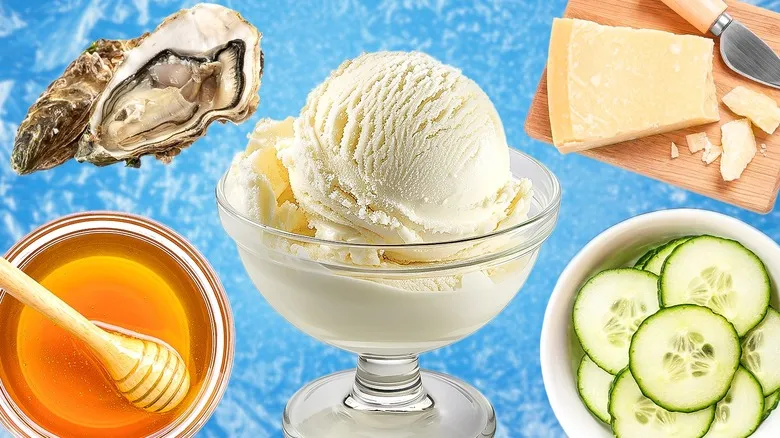Parmesan ice cream
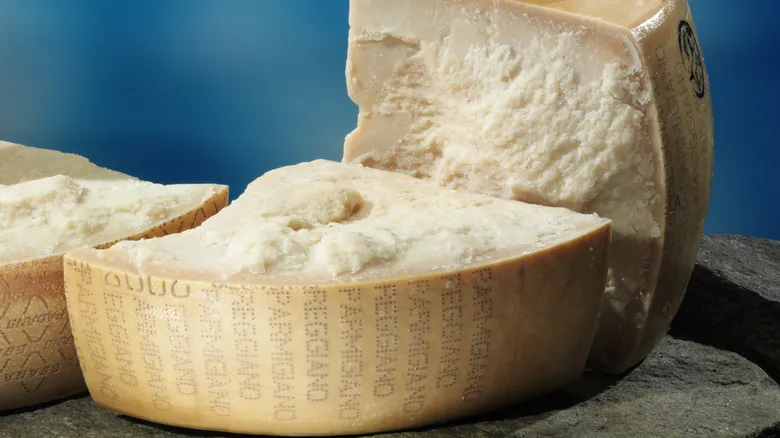
In the 1700s, countries such as France, England, and the U.S. featured a variety of popular ice cream flavors, both sweet and savory. One notable savory flavor from the 18th century is parmesan cheese. This recipe appears in Frederick Nutt's 1789 cookbook, "The Complete Confectioner," as well as in the earlier French cookbook "Le Cannameliste Français," published in 1768. While parmesan ice cream may seem unconventional today, its ingredients are still readily available: eggs, heavy cream, simple syrup (made by heating and dissolving cane sugar in water), and, of course, parmesan cheese. It's best to use freshly grated parmesan, as the additives in pre-grated varieties can hinder melting.
Though parmesan ice cream might sound strange or unappealing, many adventurous contemporary cooks who have sampled it report that it is surprisingly delicious! The flavor is often described as smooth and creamy, with rich, savory notes from the parmesan, which is known for its nutty taste.
Tutti frutti
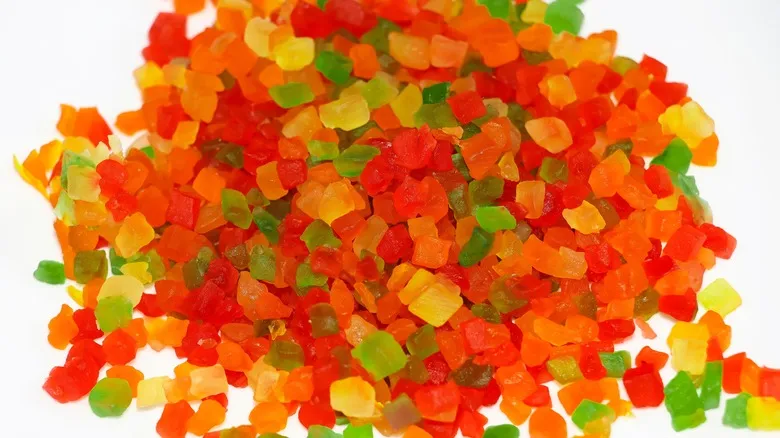
"Tutti frutti" means "all fruits" in Italian. This expression can have various interpretations, including a combination of candied fruits, but many of us likely connect it primarily with a specific ice cream flavor, even if we haven't tried it. Tutti frutti ice cream features a fruity base dotted with vibrant candied fruits, and sometimes nuts as well. The earliest known reference to tutti frutti ice cream appears in an English recipe from 1860, but it gained significant popularity in the mid-20th century, becoming a staple in ice cream shops and the frozen food aisles of grocery stores. However, over the years, this delightful treat has seen a decline in popularity and has largely disappeared from store shelves.
You can still find tutti frutti ice cream in certain Asian countries, such as India, as well as in some ice cream parlors. For most of us, though, if you want to enjoy tutti frutti ice cream today, you'll likely need to make it yourself. There are numerous recipes for homemade tutti frutti ice cream available online. While many of these recipes call for fresh fruit instead of candied varieties, you can certainly incorporate candied fruits if you're aiming for that classic tutti frutti experience.
Interestingly, when you see images of tutti frutti ice cream, you might assume the base is vanilla or strawberry flavored. In reality, the ice cream is typically a blend of several fruits, traditionally including banana, maraschino cherries, and pineapple. The dairy component consists of evaporated and liquid milk.
Water buffalo milk and camphor ice cream
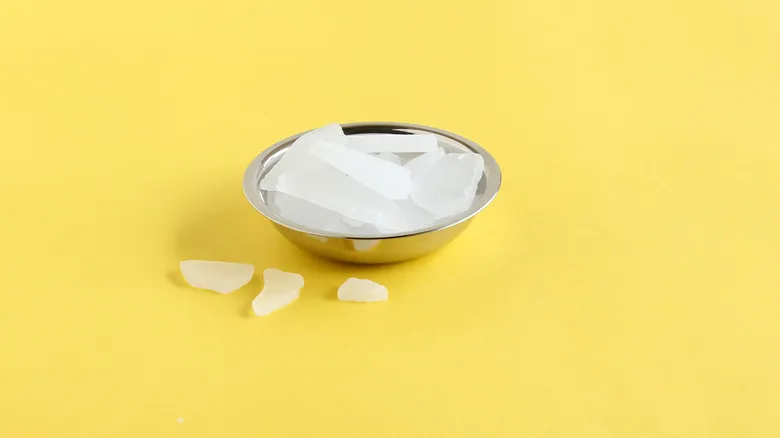
There are two undeniable facts regarding the history of ice cream. Firstly, the true origin of ice cream remains a mystery, as no one can definitively say who created it. Secondly, Marco Polo did not introduce ice cream to Europe from China. However, there is a kernel of truth in the Marco Polo narrative: the practice of combining ice with a dairy product likely originated in China. Historical records indicate the existence of a unique frozen delicacy made from ice, flour, camphor, and water buffalo milk (with some accounts also mentioning goat's milk) that dates back to the Tang Dynasty (618-907 CE).
Unlike many other flavors on our list, it's challenging to envision the taste of this ancient frozen treat, particularly since no contemporary food historian or adventurous food blogger seems to have attempted to recreate it. Nevertheless, there are ways to glean some insights. Edible camphor is still prevalent in Indian and Chinese cuisines today, and its flavor has been described as woodsy and sharp, akin to menthol. If you've ever tasted buffalo mozzarella (mozzarella di bufala), you can imagine the flavor of water buffalo milk, which is often characterized by food experts as creamy or indulgent.
Cucumber ice cream
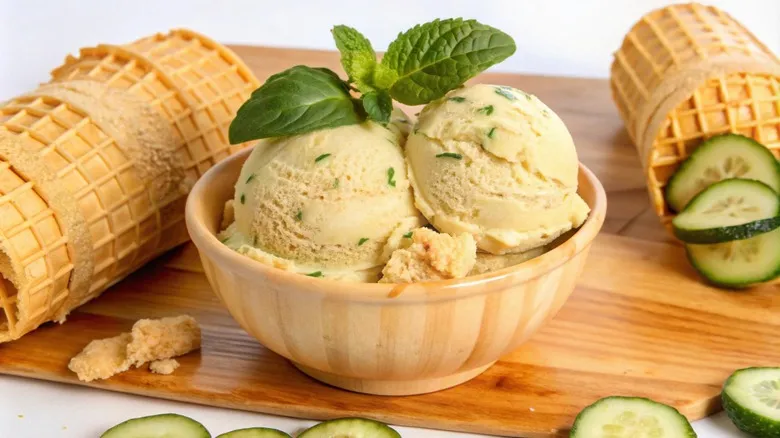
Cucumber ice cream is another intriguing savory flavor, often linked to Agnes Marshall, famously known as the "Queen of Ices." In 19th century England, Marshall gained recognition for her cooking school and cookbooks, which included a variety of ice cream recipes. While this delightful treat was primarily associated with the affluent, advancements in technology throughout the century made it more accessible to the general public.
Marshall played a significant role in this shift; she not only invented and marketed ice cream-making tools, including an early model of the ice cream maker, but also sold molds that shaped the ice cream to resemble the ingredients used for flavoring—an innovative and fashionable presentation in the 1800s. Although she did not create cucumber ice cream, she certainly promoted and popularized it, showcasing several variations of the recipe in her 1885 book, "The Book of Ices."
The fundamental recipe for cucumber ice cream calls for a large cucumber, along with ingredients like lemon juice and ginger brandy to aid in the transformation into ice cream. Cream, water, and caster sugar complete the mixture—except for one final touch. Victorians often enhanced their ice cream with artificial colorings, so if you wish to prepare this recipe in true Victorian style, consider adding some green food coloring. Whether you choose to include food coloring or not, modern cooks who have tried cucumber ice cream generally agree that it is both sweet and refreshing.
Jell-o Pudding Pops
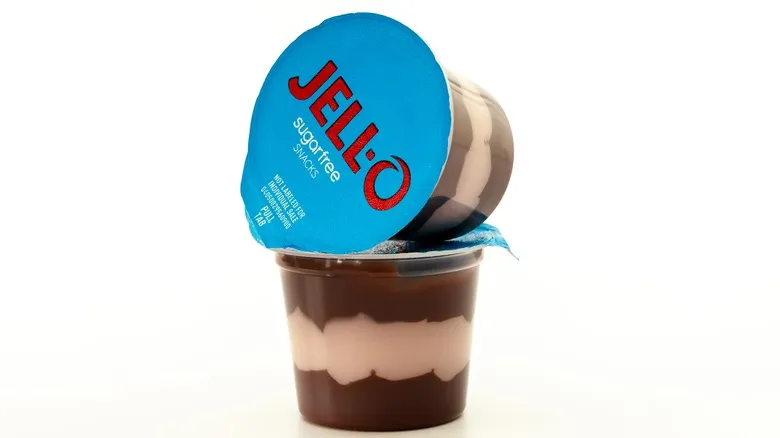
Forgotten ice cream flavors aren't merely relics of the past. Launched in 1981, Jell-o Pudding Pops quickly gained popularity, with commercials featuring spokesperson Bill Cosby becoming as memorable as the treats themselves. You might assume that the decline in sales was due to the troubling revelations about Cosby. However, the actual reason for the discontinuation of Jell-o Pudding Pops was related to production challenges and a drop in quality. While the creamy, delightful Pops consistently sold well, the company struggled to make a profit due to high production costs.
In 2004, production was handed over to the experts at Popsicle, who also acquired the rights to the name. However, those of us who experienced the original know that the new version tasted like a diluted imitation. This led to a significant drop in sales. By 2010, Popsicle ceased production of Jell-o Pudding Pops, primarily because the revamped version did not perform well in the market. The absence of Jell-o Pudding Pops in stores is still felt by those of us who grew up enjoying them, but fortunately, you can recreate them at home using Jell-o pudding and milk poured into ice pop molds.
Honey and nectar shaved ice
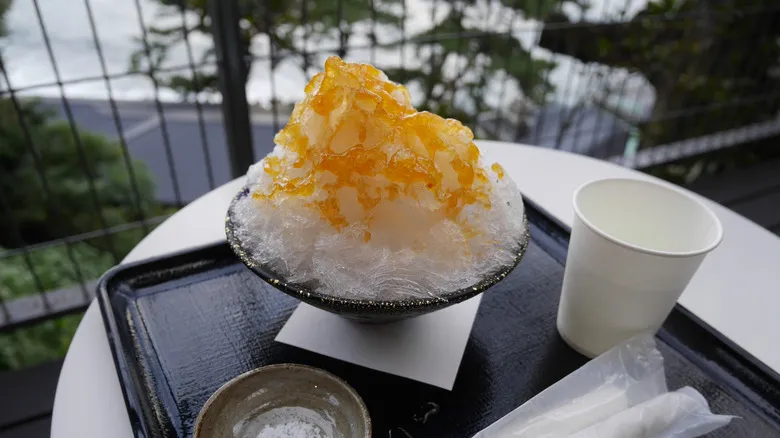
In contrast to the other ice creams featured in our selection, the combination of honey and nectar drizzled over ice or snow is dairy-free. However, it would be remiss not to mention this classic frozen delight, as it was a favorite of the legendary Alexander the Great. While this renowned conqueror's cherished dessert may appear straightforward, obtaining ice was often quite challenging until the late 19th century CE, especially if you weren't in a region where it was readily available. As a result, ice topped with nectar and honey was considered a luxurious indulgence. In fact, Alexander wasn't the only affluent individual to savor this frozen treat; Emperor Nero and other wealthy Romans also relished ice with honey (without nectar) many centuries later.
Today, ice with honey has largely been overshadowed by more intricate flavors in the realm of frozen desserts. Yet, this delicacy from the Ancient World is actually the simplest treat on our list to recreate. All you need is some shaved ice, liquid honey, and a nectar (fruit syrup) of your choice, and you'll have a dessert worthy of a daring conqueror or a Roman emperor!
Ambergris ice cream

While references to ice cream can be traced back even further, the earliest known printed recipe for ice cream dates to 1665. This recipe, authored by Anne Fanshawe, the spouse of England's ambassador to Spain at the time, features cream infused with flavors such as mace, orange water, or ambergris. The inclusion of ambergris is particularly noteworthy today. Once a favored yet costly ingredient for seasoning various dishes, including desserts, ambergris was also utilized in the production of perfumes, a practice that continues to this day.
Ambergris is a fragrant, musky substance formed from the indigestible remnants of giant squid found in the stomachs of certain sperm whales, mixed with the whale's waste. When this solid mass is expelled from the whale, it floats to the ocean's surface, where it is preserved in seawater and sun-heated until it eventually washes ashore or is discovered by someone. Due to its rarity, ambergris is also highly prized.
While some may find its earthy scent off-putting, others hold it in high regard. Christopher Kemp, an ambergris enthusiast and author of a book on the subject, described it to Smithsonian Magazine as having both woody and floral notes. However, ambergris ice cream likely did not carry this aroma; instead, it would have enriched the vanilla flavor of the cream. This was the conclusion reached by food podcasters Cynthia Graber and Nicola Twilley when they sampled a contemporary version.
The hosts of Gastropod enjoyed the experience, sharing with Business Insider that the ambergris enhanced the vanilla flavor, adding depth and complexity. If you're interested in attempting to make ambergris ice cream, be aware that the key ingredient is not only expensive but also potentially illegal. The possession or use of natural ambergris is prohibited in many countries, including the United States.
Artichoke ice cream
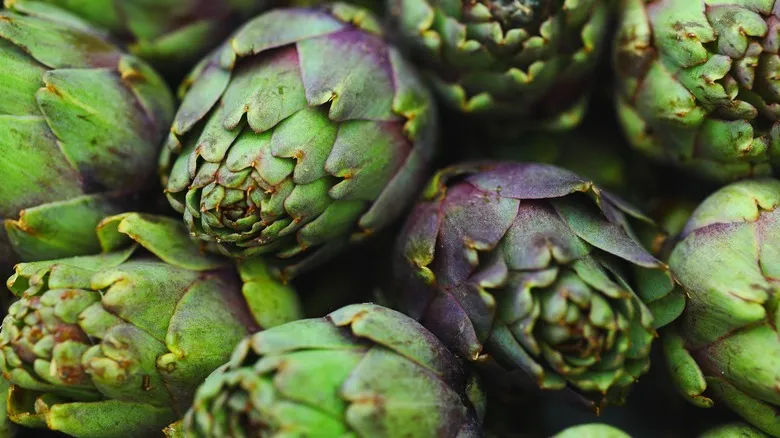
The British Museum refers to the 18th century as "the golden age of ice cream," noting that London offered a greater variety of flavors during that period than most ice cream shops do today. Among these flavors was artichoke, but a closer look at one of the frequently referenced artichoke ice cream recipes reveals that the vegetable wasn't the sole highlight. In the 1768 cookbook "Le Cannaméliste Français," author Joseph Gilliers incorporates other delicious ingredients such as pistachios and candied orange. This suggests that the overall taste was not just artichoke or even a simple combination of artichoke and cream.
While you won't find it in grocery stores today, artichoke ice cream has gained popularity among artisanal ice cream makers and adventurous home cooks. Similar to their 18th-century predecessors, contemporary artichoke ice creams often include a variety of other flavorful components, such as coffee and chocolate.
The Choco Taco
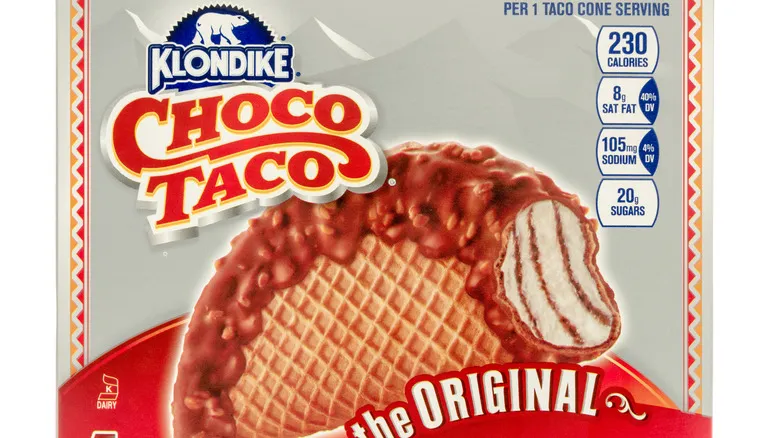
Much like tutti frutti, the Choco Taco serves as a stark reminder that a catchy name, unique texture, and delightful flavor don't necessarily ensure the longevity of an ice cream treat. Introduced in 1984, this ice cream taco—featuring a crunchy, cone-like shell coated in chocolate and nuts—quickly won over fans and became a staple from both stores and ice cream trucks.
However, in 2022, millennials who cherished the Choco Taco were taken aback when Klondike, a brand under the Unilever umbrella, announced it would be discontinuing the beloved dessert. As with many recent food shortages or product discontinuations, the explanation was somewhat unclear. The company stated that the demand for its other offerings was too high, leading to the Choco Taco's demise. Fans were devastated by the loss of this nostalgic flavor. Reddit co-founder Alexis Ohanian even proposed purchasing the rights to the treat to "preserve it for future generations," but his efforts were unsuccessful.
Since then, there have been discussions about a potential revival, but as of now, no significant comeback for the Choco Taco has materialized. For the time being, the only way to satisfy your Choco Taco cravings is to create them at home. A quick online search will yield numerous recipes for this delicious, nostalgic delight.
Oyster ice cream
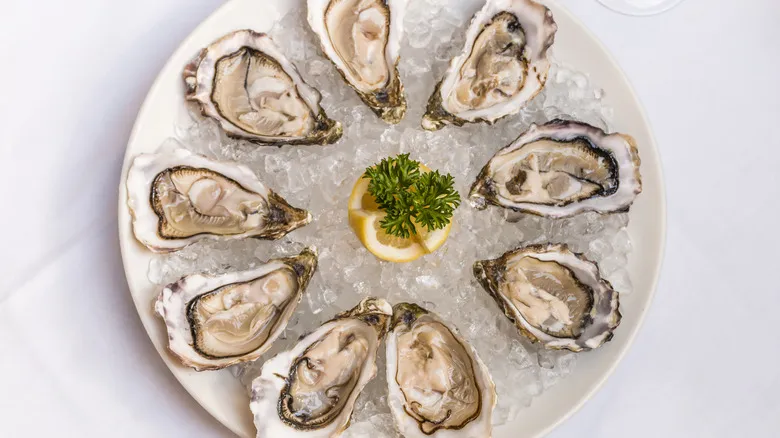
The combination of seafood and ice cream may seem unusual to many of us today. However, in the 1800s, when oysters were a highly sought-after delicacy in America and England, and ice cream was becoming widely available, it might have made perfect sense. If you search for "oyster ice cream," you'll often find articles claiming it was a favorite of figures like George Washington and James and Dolly Madison, that it was served at the White House, and even at the first Thanksgiving. Some sources suggest it was Mark Twain's preferred ice cream flavor, with a mention in "Tom Sawyer." These assertions have motivated many contemporary chefs to attempt to recreate the dish. However, a 2016 article by journalist Alex Swerdloff in Vice found no evidence to support these claims.
The only verified historical reference to oyster ice cream appears in one of the earliest American cookbooks, "The Virginia Housewife," published in 1824. Regardless of the veracity of its historical popularity, one thing is certain: modern chefs who have made it generally find it quite enjoyable. Chef José Andrés, known for reviving traditional American recipes, explained to NPR that making it is akin to preparing an oyster stew and then chilling it. After trying the recipe, he described the outcome as "amazing." Historians at George Washington's Ferry Farm, who also made oyster ice cream, had mixed reactions. They concluded that to appreciate it, one really needs to be a fan of oysters. Nevertheless, they found the recipe straightforward, so if you enjoy oysters, oyster ice cream might be worth a shot!
Recommended
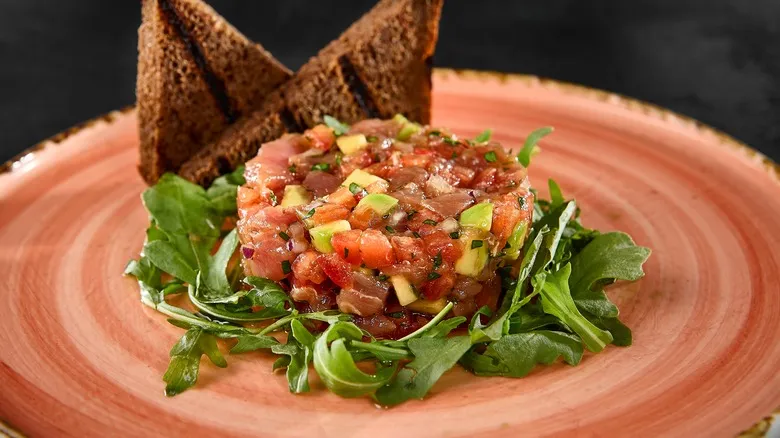
How Tuna Tartare Went From A Last Minute Substitute To Prestige Appetizer

What Exactly Is Paprika Made From?
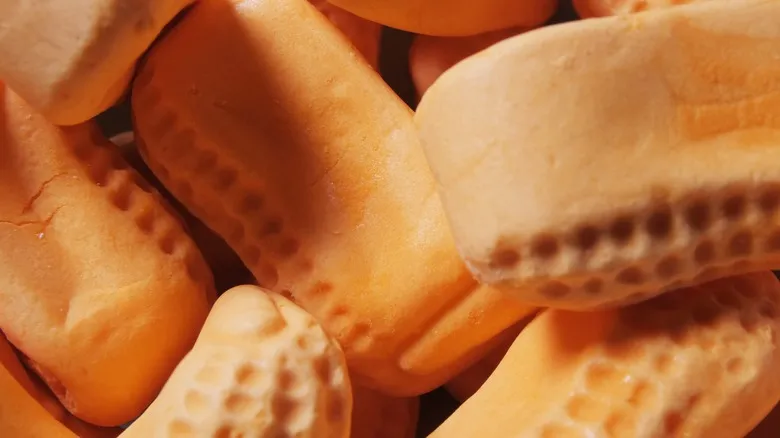
What Flavor Are Candy Circus Peanuts, Anyway?
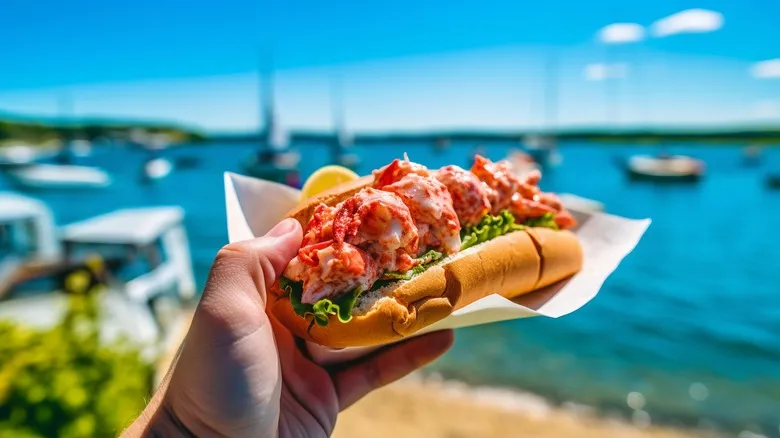
The Exact Difference Between Maine And Connecticut Lobster Rolls
Next up

